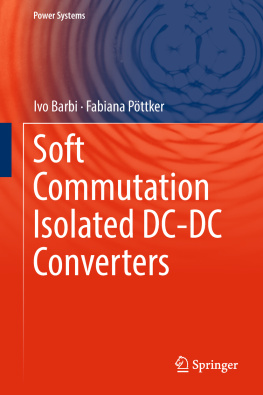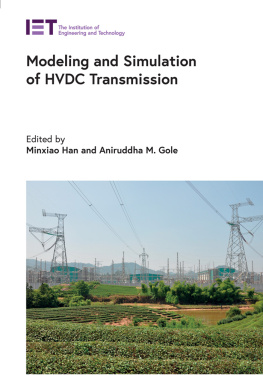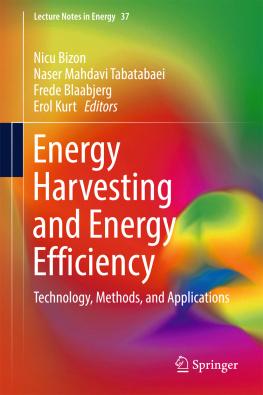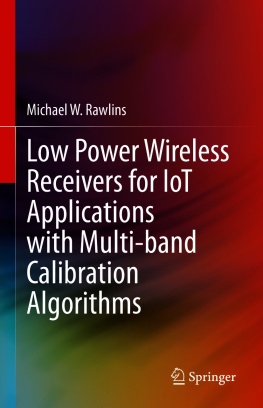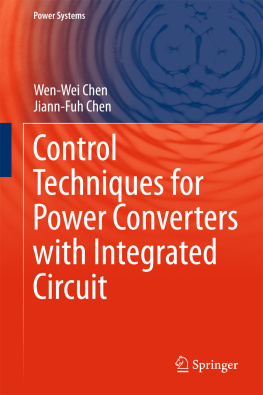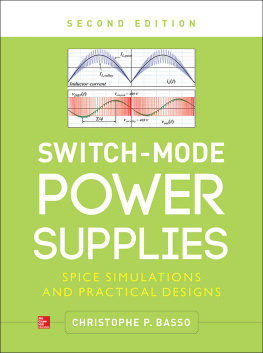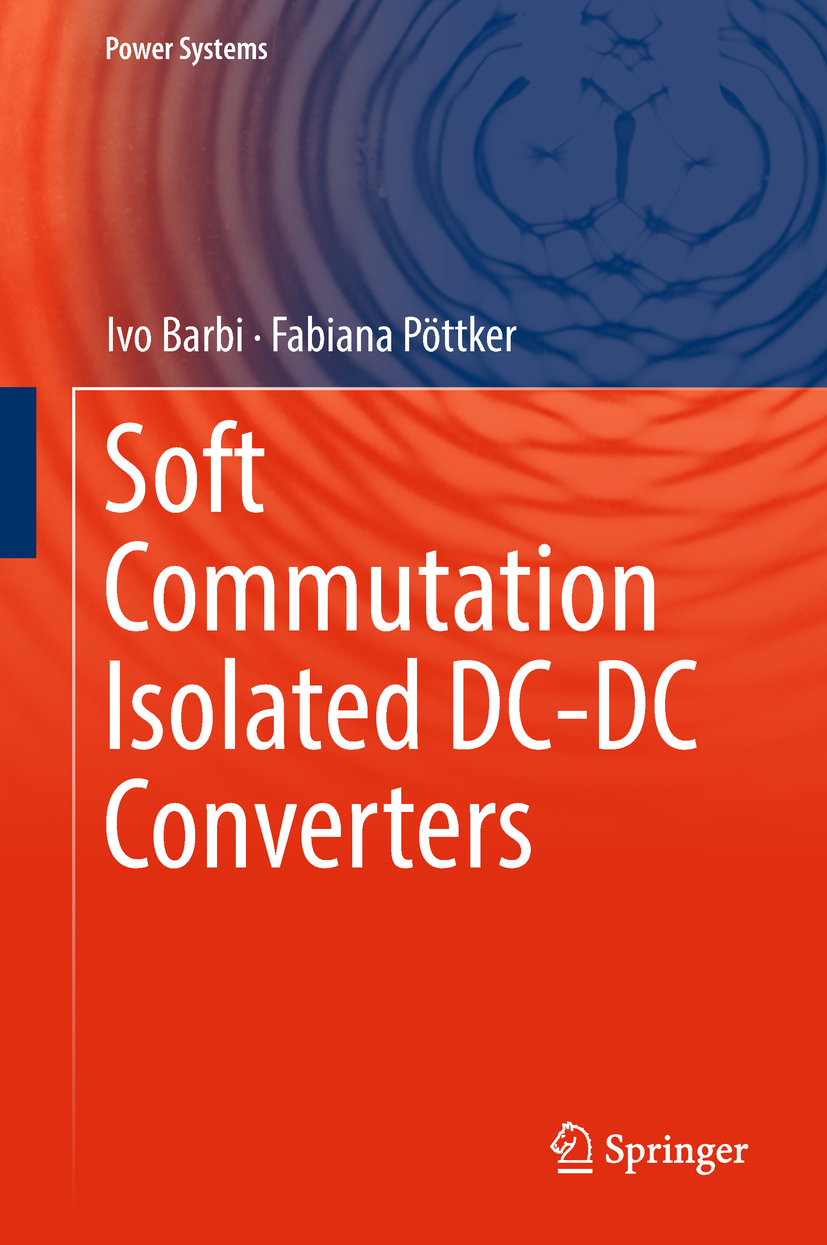Power Systems
More information about this series at http://www.springer.com/series/4622
Ivo Barbi and Fabiana Pttker
Soft Commutation Isolated DC-DC Converters
Ivo Barbi
Federal University of Santa Catarina, Florianpolis, Santa Catarina, Brazil
Fabiana Pttker
Department of Electronics, Federal University of TechnologyParan, Curitiba, Paran, Brazil
ISSN 1612-1287 e-ISSN 1860-4676
Power Systems
ISBN 978-3-319-96177-4 e-ISBN 978-3-319-96178-1
https://doi.org/10.1007/978-3-319-96178-1
Library of Congress Control Number: 2018948691
Springer International Publishing AG, part of Springer Nature 2019
This work is subject to copyright. All rights are reserved by the Publisher, whether the whole or part of the material is concerned, specifically the rights of translation, reprinting, reuse of illustrations, recitation, broadcasting, reproduction on microfilms or in any other physical way, and transmission or information storage and retrieval, electronic adaptation, computer software, or by similar or dissimilar methodology now known or hereafter developed.
The use of general descriptive names, registered names, trademarks, service marks, etc. in this publication does not imply, even in the absence of a specific statement, that such names are exempt from the relevant protective laws and regulations and therefore free for general use.
The publisher, the authors and the editors are safe to assume that the advice and information in this book are believed to be true and accurate at the date of publication. Neither the publisher nor the authors or the editors give a warranty, express or implied, with respect to the material contained herein or for any errors or omissions that may have been made. The publisher remains neutral with regard to jurisdictional claims in published maps and institutional affiliations.
This Springer imprint is published by the registered company Springer Nature Switzerland AG
The registered company address is: Gewerbestrasse 11, 6330 Cham, Switzerland
To Antnio Barbi and Adriana Barbi.
Ivo Barbi
To my beloved husband, Douglas, for his encouragement and support.
Fabiana Pttker
Preface
Power electronics can be defined as the applied science dedicated to the electrical energy processing by the use of power semiconductors as switches. The use of static converters in the processing and control of electrical energy matured in the twentieth century to the point of becoming a vital technology of great economical relevance to society. There is a number of benefits of power electronics when compared to previous techniques including lower cost, high efficiency, high power density, and simplicity of control.
The static power converters, according to whether the input and output are alternating current (AC) or direct current (DC), are classified into four basic types: DC-DC converters, AC-DC converters, DC-AC converters, and AC-AC converters. The DC-DC converters are designed to control the power flow from a DC power source to another. They may be unidirectional or bidirectional, isolated or not. Their power ranges from a few watts to hundreds of kilowatts, while their voltage ranges from a few volts to tens of kilovolts.
DC-DC converters are used in personal computers, mobiles, electrical vehicles, lighting, railway systems, microgrids, medical equipment, avionics, and many other applications.
To optimize the power efficiency of isolated DC-DC converters, soft commutation is mandatory, particularly in high power density applications.
The aim of the authors is to present a detailed description and a quantitative analysis of the most common unidirectional soft-commutated isolated DC-DC converters, focusing on the soft commutation process, its quantitative and mathematical analysis, and the quantification of the switching parameters.
This book evolved from the authors long-term experience at two Brazilian Universities: the Federal University of Santa Catarina (UFSC) and the Federal University of TechnologyParan (UTFPR) for graduate and undergraduate electrical engineering students. Hence, this book provides valuable information for power electronics engineers, graduate and undergraduate students, as well as researchers at universities and research institutes.
During the planning and writing of this book, we have incurred indebtedness to many people, particularly our graduate students who for years, through successive generations, have helped us to improve our texts, our methods of work, and especially our way of teaching.
Ivo Barbi
Fabiana Pttker
Florianpolis, Santa Catarina, Brazil Curitiba, Paran, Brazil
June 2018
Acknowledgements
Ivo Barbi would like to thank and acknowledge valuable support provided by Jos Airton Beckhuser Filho, Leonardo Freire Pacheco, Guilherme Martins Leandro, and Ygor Pereira Marca.
Fabiana Pttker acknowledges the support of the Federal University of TechnologyParan, for providing sufficient time and a three-month sabbatical to work on this book.
Abbreviations
CCM
Continuous conduction mode
CVC
Capacitor voltage clamped
DC
Direct current
DCM
Discontinuous conduction mode
FB
Full bridge
HB
Half bridge
LC
Inductor capacitor
LCT
Inductor capacitor thyristor
PFM
Pulse frequency modulation
PWM
Pulse width modulation
RC
Resistor capacitor
RCT
Resistor capacitor thyristor
RL
Resistor inductor
RLC
Resistor inductor capacitor
SRC
Series resonant converter
ZCS
Zero current switching
ZVS
Zero voltage switching
Contents
Springer International Publishing AG, part of Springer Nature 2019
Ivo Barbi and Fabiana Pttker Soft Commutation Isolated DC-DC Converters Power Systems https://doi.org/10.1007/978-3-319-96178-1_1
1. Basic Electric Circuits with Switches
Ivo Barbi
(1)
Federal University of Santa Catarina, Florianpolis, Santa Catarina, Brazil
(2)
Department of Electronics, Federal University of TechnologyParan, Curitiba, Paran, Brazil
Ivo Barbi (Corresponding author)
Email:
Nomenclature
Vi
Input DC voltage
E1
DC voltage
vC
Capacitor voltage
iC
Capacitor current
vL
Inductor voltage
vR
Resistor voltage
vS
Switch voltage
Time constant
S
Switch
D
Diode
T, T1 and T2
Thyristors
Io and iL()
Steady state inductor current
vL() and vR()
Steady state inductor and resistor voltages, respectively
W
Energy
tf
Energy recovery time interval
N1 and N2
Transformer primary and secondary windings, respectively
Lm
Transformer magnetizing inductance

Transformer magnetizing inductance referred to the secondary winding
v1 and v2
Transformer primary and secondary voltages, respectively
t1 and t2
Time interval 1 and 2, respectively

